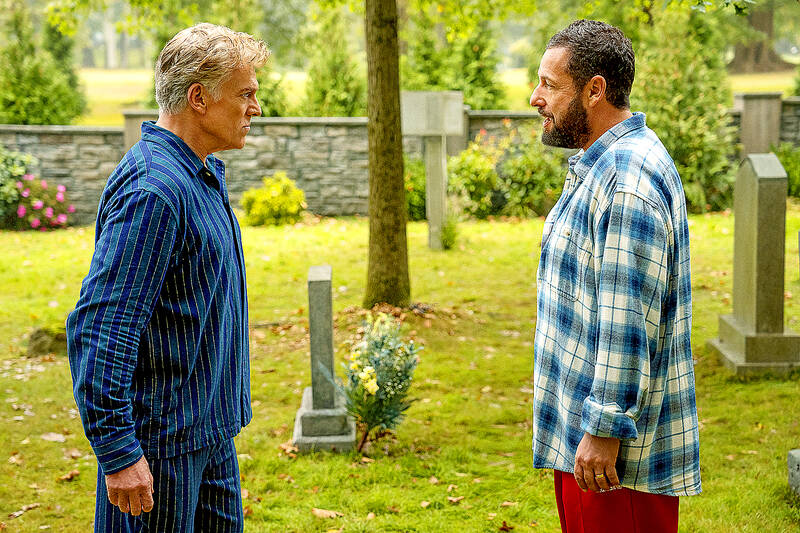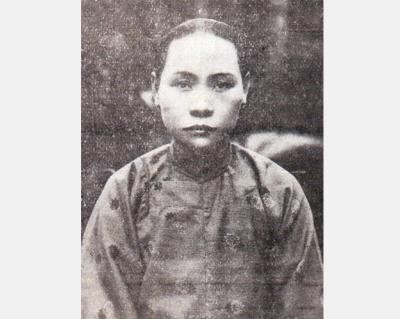Happy Gilmore 2, the much-anticipated follow-up to the canonical sports comedy that dominated pop culture at the turn of the century, opens with Adam Sandler’s irascible hero catching viewers up on the past 29 years.
After humiliating tour nemesis Shooter McGavin (an on-form Christopher McDonald) in the big tournament and riding off into the sunset with the girl, they marry and have five children as Happy’s prosperity continues unbidden. He considers stepping back from the game as his years and wealth stack up, but keeps going at the encouragement of his dear Virginia (Julie Bowen). But when she’s removed from the picture his world is even more upended than it was when we met him as an orphan in 1996.
This time, instead of having to abandon his first love (hockey) to chase down a couple hundred grand in cardboard checks to save grandma’s house, he abruptly retires to be more present for his kids and assumes the bills are covered until the feds circle back to take grandma’s house — and the Ferrari. With his four boys old enough to fend for themselves, sort of, he moves into a ramshackle triplex on the sketchy side of town with his young daughter, Vienna (played by Sunny Sandler, Adam Sandler’s youngest daughter), and falls into alcoholism. It isn’t until Vienna’s ballet instructor (played by Jackie Sandler, Adam Sandler’s wife) tells Happy that Vienna has the talent to study at a prestigious company in Paris that he becomes motivated to pick up his club bag and try to raise the tuition money. But the comeback gets complicated when Happy picks up a DUI in a municipal course karting accident and an energy drink hustle bro offers him pride of place in an upstart golf tour that’s purpose-built to take down the establishment. (Sound familiar?)

Photo: Netflix via AP
Like most sequels, Happy Gilmore 2 doesn’t quite live up to its predecessor, the spiritual successor to Caddyshack. But it won’t matter to diehard fans who never stopped quoting lines from the original. I still can’t let a limousine pass without reflexively muttering “must be Burt Reynolds,” the line that introduced McGavin. That’s not to say the yarn Sandler and co-writer Tim Herlihy stitched together is no fun. They still manage to get in their share of recurring gags (Happy making flasks out of anything that comes to hand: a club brush, a TV remote) while divvying up those other comedy moments among their SNL pals (Kevin Nealon, Jon Lovitz) and cherished Sandler company regulars (Rob Schneider, Steve Buscemi). They even manage to pay tribute to the actors who died between films — not least the late great Carl Weathers, AKA Chubbs the one-handed golf pro — by staging a fight between Happy and McGavin in a cemetery, itself a tribute to the gameshow host Bob Barker’s iconic original cameo.
But where the first Happy Gilmore was the story of a rank outsider’s takeover of the game, in this installment it’s the other way around. Happy isn’t just a king of the long ball, but a peer to rival Tiger Woods and other greats. Lee Trevino, the only pro golfer who appeared in the 1996 film, finds himself in the sequel surrounded by greats of today (Jordan Spieth, Xander Schauffele) and yesteryear (Jack Nicklaus, Fred Couples). John Daly, whose actual rollercoaster life no doubt inspired Happy’s second act, lives in Happy’s garage. Scottie Scheffler sends up his bizarre arrest at the 2024 PGA Championship and Will Zalatoris finally gets to dine out on his uncanny resemblance to Happy’s very first caddie. If the original Happy Gilmore was intended as a love letter to the game, it’s clear 30 years on that the professional golf community got the message.
The most interesting thing about the sequel is its commitment to defending the game and its traditions — a cause Happy eventually takes in addition to helping Vienna realize her ballet dream, while reckoning with the fact that everyone can smash the long ball now. All the while, the scenes of Happy teeing off on a pro shop simulator and weekend warriors busting chops speak to the franchise’s contribution to making the game more approachable. Now, the unwavering focus on this theme doesn’t completely redeem the film’s woolier elements — the endless sports cameos (from Travis Kelce to the WNBA’s Kelsey Plum), the rampant nepotism (again: every member of Sandler’s immediate family is featured), the forced integration of Call Her Daddy and other digital media platforms, and a batshit third act that draws out the film’s two-hour runtime. But it does make them chafe a bit less. All the while, Bad Bunny provides more salve in the role as Happy’s busboy turned caddie, Oscar, and proves to be a surprising and delightful laugh riot.

Photo: Netflix via AP
For those who aren’t into golf or weren’t around for SNL at the turn of the century, Happy Gilmore 2 could well sail overhead like a drive from the man himself. But for the generations who still quote summer comedies from eons ago (ahem), Sandler’s second round offers a refreshing trip down memory lane — to see what new hijinks the assisted living orderly (Ben Stiller) and the IRS agent (Robert Smigel) are up to, and if McGavin, the greatest villain in sports movie history, ever gets his revenge. Everything else — relics of a simpler, less serious time perhaps — is par for the course.

The Lee (李) family migrated to Taiwan in trickles many decades ago. Born in Myanmar, they are ethnically Chinese and their first language is Yunnanese, from China’s Yunnan Province. Today, they run a cozy little restaurant in Taipei’s student stomping ground, near National Taiwan University (NTU), serving up a daily pre-selected menu that pays homage to their blended Yunnan-Burmese heritage, where lemongrass and curry leaves sit beside century egg and pickled woodear mushrooms. Wu Yun (巫雲) is more akin to a family home that has set up tables and chairs and welcomed strangers to cozy up and share a meal

Dec. 8 to Dec. 14 Chang-Lee Te-ho (張李德和) had her father’s words etched into stone as her personal motto: “Even as a woman, you should master at least one art.” She went on to excel in seven — classical poetry, lyrical poetry, calligraphy, painting, music, chess and embroidery — and was also a respected educator, charity organizer and provincial assemblywoman. Among her many monikers was “Poetry Mother” (詩媽). While her father Lee Chao-yuan’s (李昭元) phrasing reflected the social norms of the 1890s, it was relatively progressive for the time. He personally taught Chang-Lee the Chinese classics until she entered public

Last week writer Wei Lingling (魏玲靈) unloaded a remarkably conventional pro-China column in the Wall Street Journal (“From Bush’s Rebuke to Trump’s Whisper: Navigating a Geopolitical Flashpoint,” Dec 2, 2025). Wei alleged that in a phone call, US President Donald Trump advised Japanese Prime Minister Sanae Takaichi not to provoke the People’s Republic of China (PRC) over Taiwan. Wei’s claim was categorically denied by Japanese government sources. Trump’s call to Takaichi, Wei said, was just like the moment in 2003 when former US president George Bush stood next to former Chinese premier Wen Jia-bao (溫家寶) and criticized former president Chen

President William Lai (賴清德) has proposed a NT$1.25 trillion (US$40 billion) special eight-year budget that intends to bolster Taiwan’s national defense, with a “T-Dome” plan to create “an unassailable Taiwan, safeguarded by innovation and technology” as its centerpiece. This is an interesting test for the Chinese Nationalist Party (KMT), and how they handle it will likely provide some answers as to where the party currently stands. Naturally, the Lai administration and his Democratic Progressive Party (DPP) are for it, as are the Americans. The Chinese Communist Party (CCP) is not. The interests and agendas of those three are clear, but